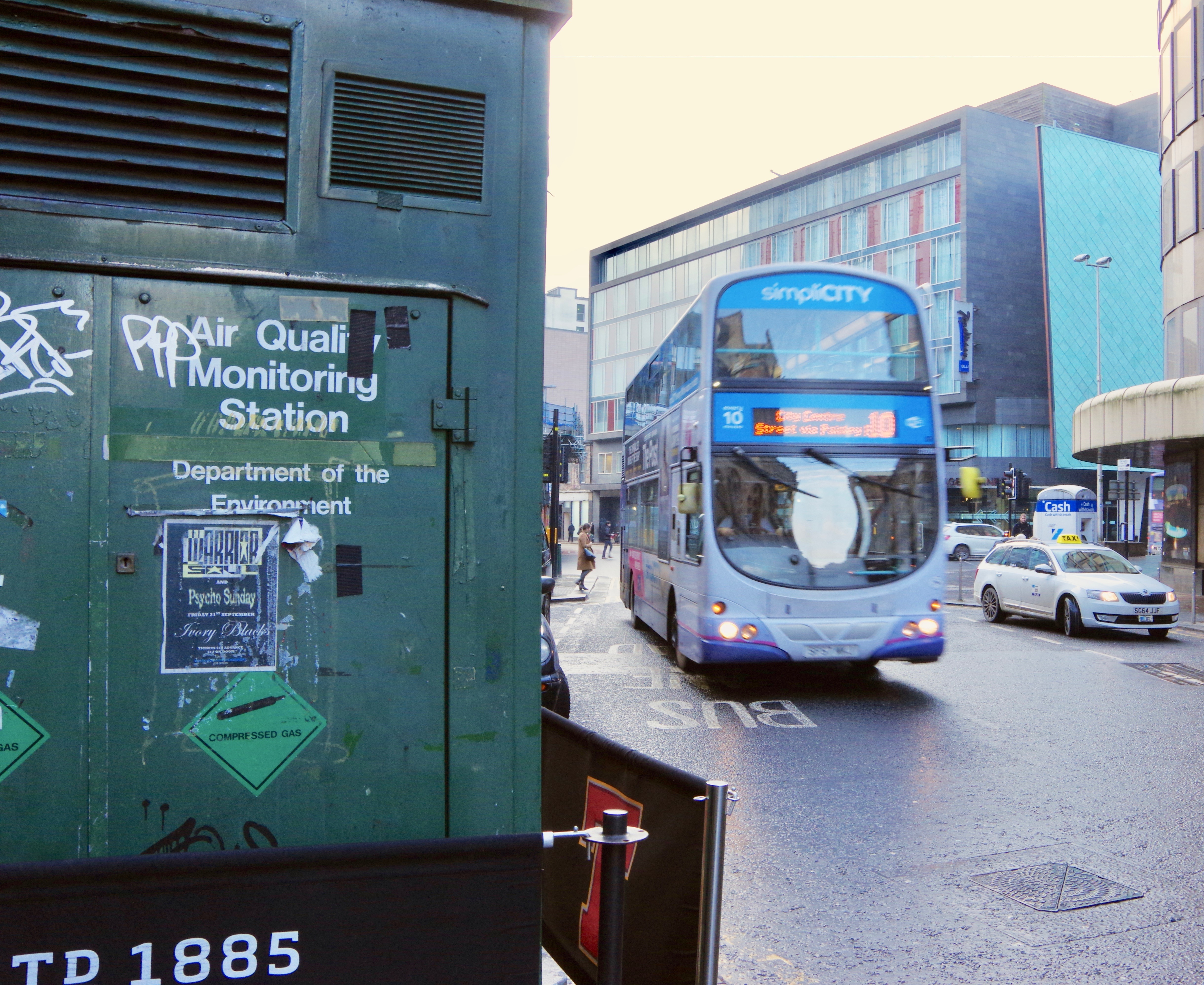
Glasgow Councillors endorse weak air pollution plans
Glasgow Councillors today progressed plans for a Low Emission Zone with an amendment despite objections from environmental campaigners and criticism that their proposals would condemn the city to illegal pollution levels for years to come. Protesters concerned about public health impacts of toxic traffic fumes staged a ‘die-in’ before the Council meeting.
The proposals endorsed at the Environment Committee will see only 20% of buses having to meet cleaner emission standards by the end of 2018, rising slowly with all buses only included by 2022. This is despite the Scottish Government making £10.8m available for the delivery of the Low Emission Zone this year and at least £10m available in loan funding for fleet upgrades. Councillors were unclear about the purpose of this funding from Government.
The Council’s proposals also failed to provide a clear timeline for when dirty cars, vans and lorries would be included in the LEZ scheme restrictions.
Air Pollution Campaigner for Friends of the Earth Scotland Emilia Hanna said:
“Today’s decision means the people of Glasgow will be exposed to illegal levels of dirty air for years to come. These weak plans will create a No Ambition Zone that will have little to no impact on the city’s air pollution problems. There appeared to be real confusion in the meeting about the money available to implement Low Emission Zones and modernise the bus fleet. The Transport Minister needs to urgently clarify whether that the £10.8m funding can be used by Glasgow City Council for their LEZ.
“Despite good efforts from several Councillors who are committed to clean air, the dinosaurs at Transport Scotland and Council officials recommending a business-as-usual type approach have won out today. The LEZ proposal will now move to the City Administration Committee for final approval and we will be challenging Councillors to improve the bus timetable at that level.
“These curent plans are so weak that they do not even intend to exhaust the £10.8m pot of money the Government has made available for LEZ implementation this year. There is no sense of urgency at all in the proposals. A more ambitious plan would encourage bus companies to use the public money provided to upgrade their fleet and bring cleaner air to Scotland’s biggest city. We want buses to be part of the solution to air pollution, and they could be if the Council aimed to have low emission buses in the city centre in the next year.
“This isn’t just a decision that affects Glasgow, setting high standards here would encourage Edinburgh, Aberdeen and Dundee to follow suit as they plan their own Zones in coming years. That’s part of the reason we’ve seen Councillors emailed by people across the country urging them to aim higher.”
Hanna concluded,
“Getting these plans right is a matter of life and death, because 300 people in Glasgow die early from air pollution every year. Glasgow City Council is now eight years behind a legal deadline to have clean air, so a half-baked No Ambition Zone is not what is needed. The city needs an ambitious, well planned Low Emission Zone that will transform the city’s air and improve lives as quickly as possible.”
ENDS
NOTES TO EDITORS
- Free to use, print quality photos of the ‘die-in’ outside Glasgow City Chambers are available at https://flic.kr/s/aHsmgcCDZd
- The LEZ Update report that was discussed at Glasgow City Council’s Environment, Sustainability and Carbon Reduction Policy Committee today http://www.glasgow.gov.uk/councillorsandcommittees/viewDoc.asp?c=P62AFQDN2U2UUTDN2U
- LEZs were first proposed in 2015, the SNP 2016 Scottish Election manifesto promised a Low Emission Zone by 2018. The Glasgow SNP promised an LEZ for the city in their 2017 council election manifesto. In September 2017 the Government confirmed the first LEZ would be in Glasgow and there there would be further Zones in Aberdeen, Dundee and Edinburgh by 2020.
- In this year’s budget the Scottish Government have committed £10.8m for LEZ delivery and at least £10m for loans to buy cleaner buses. Retrofitting an older bus to modern emissions standards involves only changing the exhaust system and in London this costs only £15,000 per bus.
- A report commissioned by Transport Scotland estimates that there are just over 800 buses in Glasgow, and approximately 15% of these (125 buses) were already Euro 6 in 2017. 83% of the buses are Euro 3,4, or 5 (677) which can all have new exhaust systems retrofitted. 677 buses could be retrofitted at a cost of £10.2m. [Report available on request]
- The City Council agreed in September that within 6 months a report would include “specific draft proposals and timescales to include vans, lorries and taxis”: http://www.glasgow.gov.uk/councillorsandcommittees/viewDoc.asp?c=P62AFQDNDNNTZLDX81
- FoES briefing on LEZs: https://foe.scot/campaign/air-pollution/what-is-a-lez/
- Friends of the Earth Scotland is
* Scotland’s leading environmental campaigning organisation
* An independent Scottish charity with a network of thousands of supporters and active local groups across Scotland
* Part of the largest grassroots environmental network in the world, uniting over 2 million supporters, 75 national member groups, and some 5,000 local activist groups.
www.foe.scot
